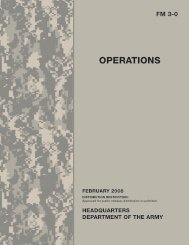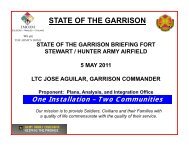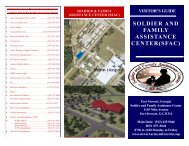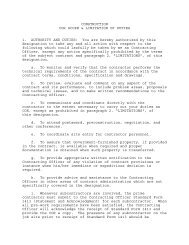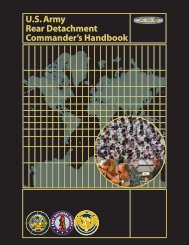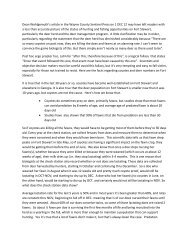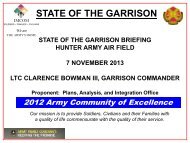3rd Infantry Division Operations - Fort Stewart - U.S. Army
3rd Infantry Division Operations - Fort Stewart - U.S. Army
3rd Infantry Division Operations - Fort Stewart - U.S. Army
You also want an ePaper? Increase the reach of your titles
YUMPU automatically turns print PDFs into web optimized ePapers that Google loves.
The Surge 33<br />
manders massed additional forces and planned the fight. The<br />
enemy could not see what was about to happen. The campaign<br />
to clear him from his hideout was set to begin. The time was<br />
ripe for change in the southern Baghdad Belts.<br />
Arab Jabour and Hawr Rajab had been home to well-off<br />
families three years earlier, but al-Qaeda had been able to occupy<br />
these towns without significant ISF or coalition forces to<br />
counter them. In those years of occupation, the enemy, namely<br />
the Abu Jurah terrorist network and al-Qaeda, had had time to<br />
prepare deadly traps. Whole buildings, called House Borne<br />
Improvised Explosive Devices (HBIED) were rigged to explode<br />
on contact, much like the vehicular version in use throughout<br />
Iraq. IEDs were positioned as mine fields. The enemy ruled<br />
the streets and understood how to use the ground for his tactical<br />
advantage.<br />
On June 16th, Multi-National <strong>Division</strong> - Center launched<br />
Operation Marne Torch in order to defeat insurgents, deny them<br />
a sanctuary, and prevent the enemy from moving accelerants<br />
from Arab Jabour into Baghdad. Spearheading this fight from<br />
the ground were the 1st Battalion, 30th <strong>Infantry</strong> and the 1st<br />
Squadron, 40th Cavalry along with elements of the Iraqi <strong>Army</strong><br />
6th <strong>Division</strong>.<br />
The battle began with an attack by Air Force bombers striking<br />
suspected caches and cutting roads with four precision<br />
guided bombs in Area of <strong>Operations</strong> (AO) "Denali," part of<br />
Arab Jabour. Secondary explosions detected by video cameras<br />
high above targets confirmed that the B-1s had hit their mark.<br />
This technique would be repeated as often as necessary to keep<br />
troops on the ground from being exposed to IED threats unnecessarily.<br />
On June 2<strong>3rd</strong>, another fourteen bombs were dropped<br />
in order to cut three roads and one road section, thus denying<br />
the enemy freedom to maneuver.




